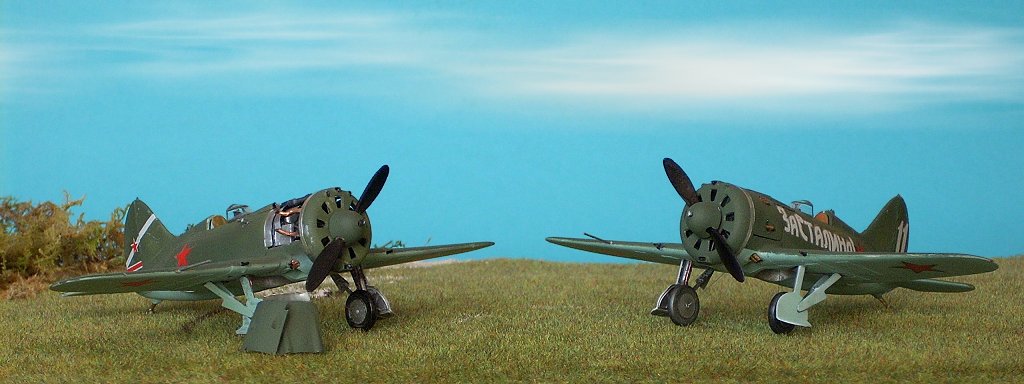
Polikarpow I-16 Rata
| Manufacturer: | Kit: | Quality: |
| ICM | Polikarpow I-16 Rata Typ 18 und 24 | |
► Teil I: Erste Schritte Der erste Tiefdecker mit einziehbarem Fahrgestell - das war die Mosca (Fliege), oder auch Rata (Ratte), wie die Polikarpow I-16 genannt wurde. Schon in Spanien im Bürgerkrieg in Verwendung, war sie auch Chinesischen, Finnischen und Deutschen Piloten als Gegner bestens bekannt. Die etwas indifferenzierte Wertung hat ihren Grund in der Tatsache, daß zwar viele, fein detaillierte Teile vorhanden sind, diese aber nicht und nicht zueinanderpassen. Diese beiden Modelle fertigzustellen, war ein Spießrutenlauf. Am Anfang stand das Bestreben, den Motor so genau wie möglich nachzubilden. Da der aus drei Teilen aufgebaut ist, schien das ohne Probleme möglich zu sein. Das Nachbilden der Kabel und Leitungen erwies sich auch als der einfachste Teil der Übung. Auch der Anbau des Motors an das Brandschott gelang rasch und gut. Danach war's vorbei, denn ist der Motor an Ort und Stelle, reichen die Motordeckel vorne und hinten nicht mehr an die anderen Teile heran - es paßt nichts mehr zusammen. An die Seitenwände kamen links und rechts die zugehörigen Gerätschaften und das Pilotenabteil ließ sich sehr einfach zusammenstellen. Selbstgemachte Sitzgurten und die aufgebohrten Auspuffe rundeten das Bild ab. Und dieser komische Bügel dient keinem anderen Zweck, als das Durchfädeln des Seiles zu erleichtern, an welchem das Fahrwerk hochgezogen wurde. Ein kleines Kunststück war der Eigenbau der beiden MG's, der Munitionszufuhr und -kisten. Der restliche Zusammenbau ging gut von der Hand, bis auf die bereits genannten Fehler in der Passung. >> Teil II: Tarnung und Markierung >> Teil III: Noch eine Rata |
► Part I: First steps The first low-wing monoplane equipped with retractable undercarriage - this was the Mosca (fly), or Rata (rat), as the Polikarpow I-16 was called. Already in action in the Spanish Civil War, the I-16 was well known to Chinese, Finnish and German pilots as a prominent opponent. The rather undifferentiated ranking causes in the fact, that there are many, well detailed parts offered in this kit, but these truly don't fit together, anyway. To finish those both kits, was truly a mess. In the beginning was the idea, to build the engine as lifelike as possible. The kit offers three parts, so this seemed to be possible without difficulties. Imitating the wires and cables just was the easiest part of the examination. I also succeeded quick in applying the engine to the bulkhead and it fitted well. Thereafter the fun was over. Placing the engine where it has to be, means, that the three engine-cowlings will not more reach to the front-cowling or even to the fuselage behind - the parts' fitting is over. I added the equipment to the left and right side-panel. The cockpit's interior was rather simply put together. Selfmade harnesses and drilling up the exhaust-pipes were the right finish to this step of assembling. And this fancy bow serves nothing else, than to make it easier to me, to thread the cable, with which the undercarriage was retracted. Scratchbuilding the MG's, the ammunition-belts and -boxes was a real little feat. The rest aof the assembling was going forward rather easy, except the already named problems of the parts' fitting. >> Part II: Camouflage and markings >> Part III: Just another Rata |
Further pictures